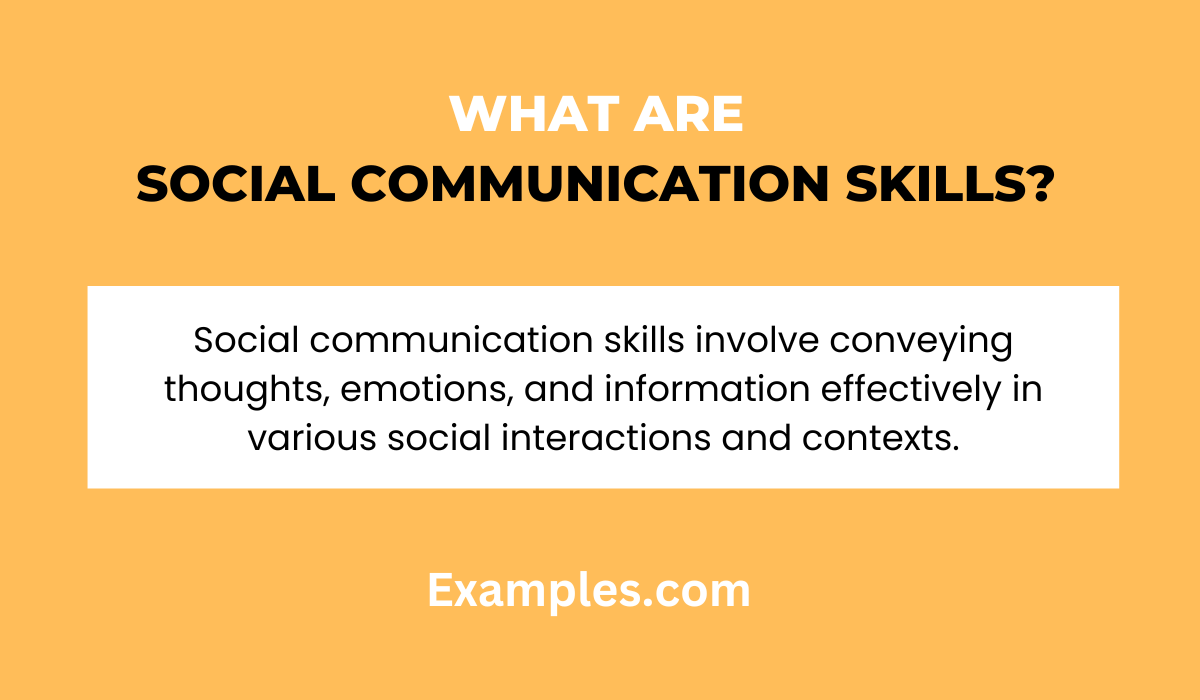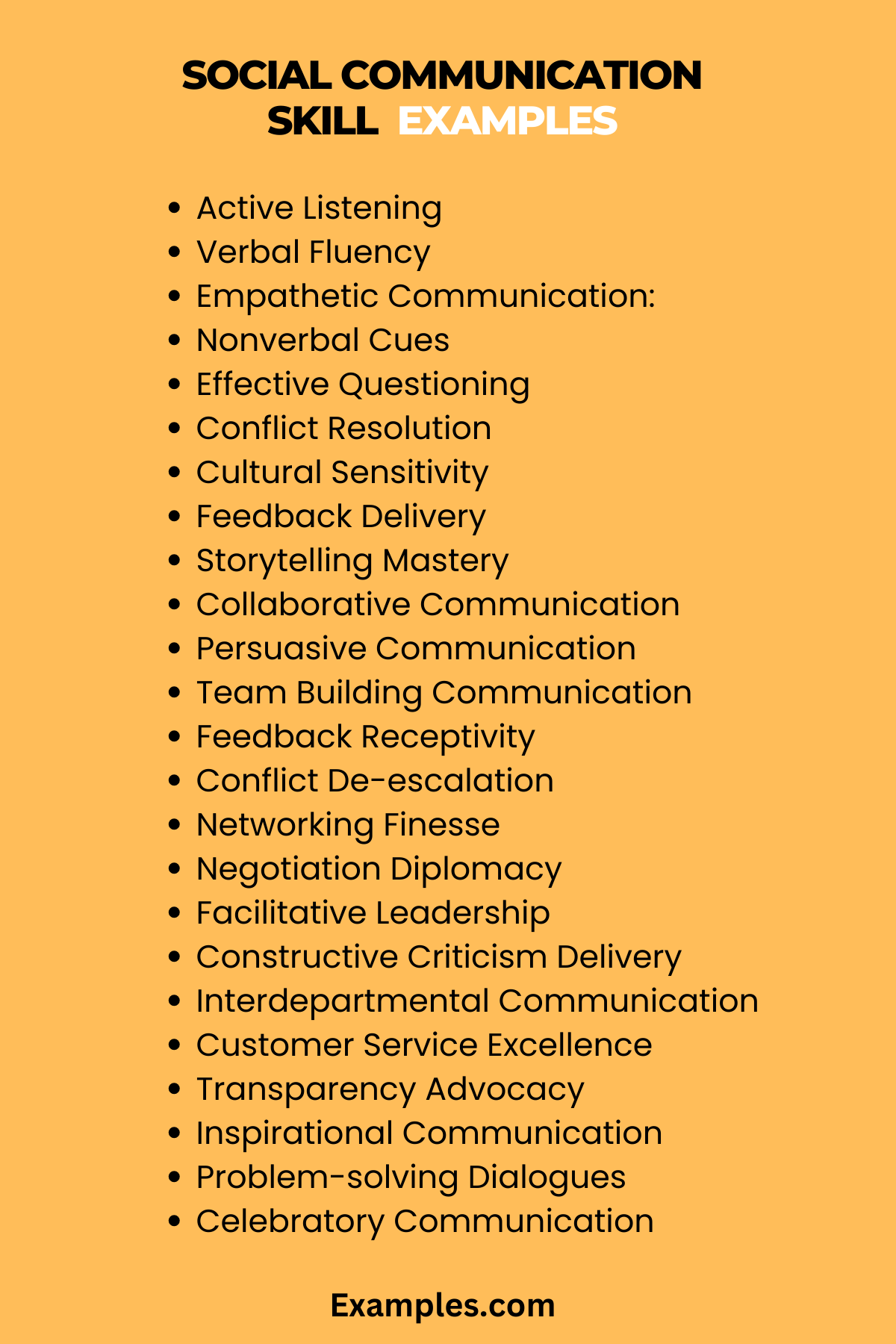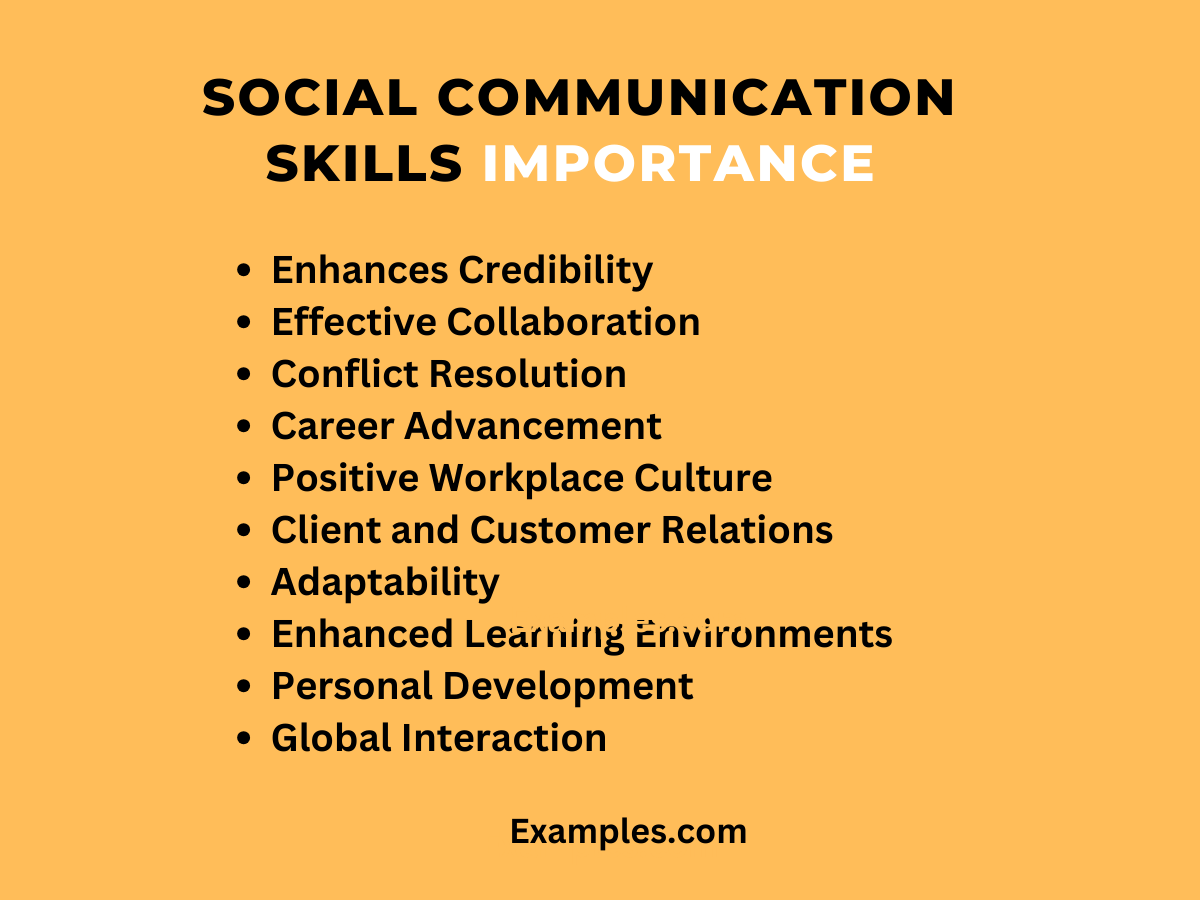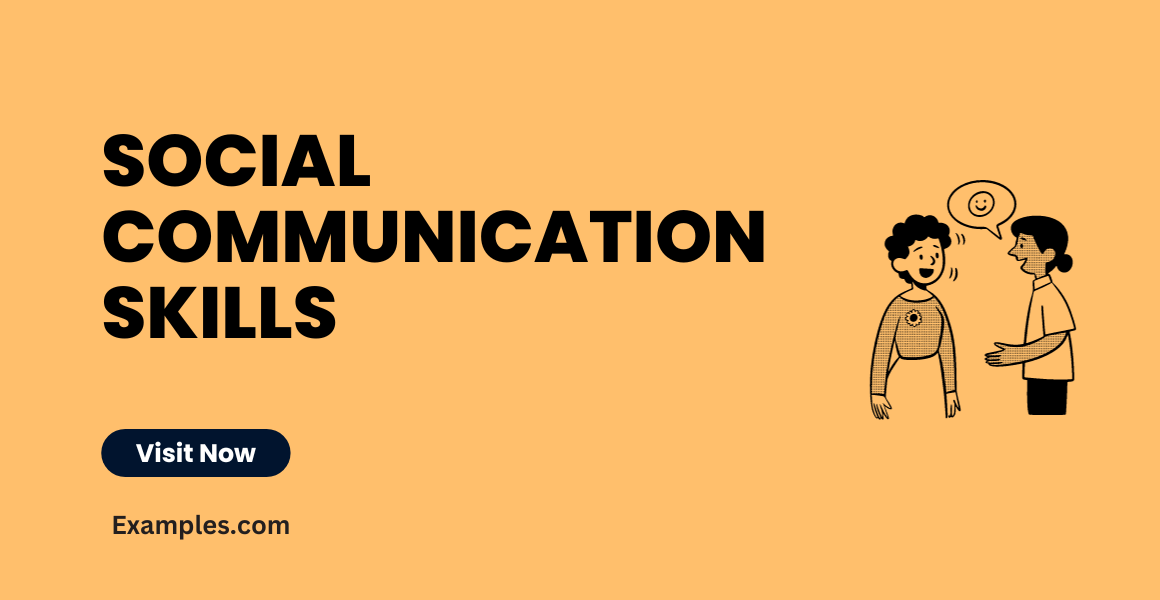29+ Social Communication Skills Examples
Embark on a journey to unravel the essence of social communication skills. These skills, crucial for effective interactions, span verbal and nonverbal aspects. Dive into a comprehensive guide that illuminates the significance, types, and challenges of social communication. Enhance your understanding through real-world communication examples, empowering you to navigate diverse social scenarios with finesse.
What are Social Communication Skills?
Social communication skills encompass the ability to convey and interpret information effectively in social settings. In simple terms, it involves the art of connecting with others through verbal, nonverbal, and written means. This skill set includes verbal fluency, active listening, empathy, and adapting communication styles based on the context. Mastering social communication fosters meaningful connections, both personally and professionally.

30 Social Communication Skills Examples
Enhance your interpersonal dynamics with our guide on Social Communication Skills. Navigating verbal and nonverbal aspects, this comprehensive resource explores the nuances of effective interaction. Discover the significance, types, and practical tips for mastering social communication. Real-world examples illuminate the path, offering insights to seamlessly connect in diverse social scenarios. Elevate your communication prowess, fostering meaningful connections both personally and professionally. Dive into the world of Social Communication Skills for a richer, more engaging social experience. Enhance your social communication skills with this diverse compilation of examples tailored for various contexts. From workplace interactions to educational settings, each example offers valuable insights into effective communication strategies.

- Active Listening:
Example: “In a team meeting, I practiced active listening, summarizing colleagues’ ideas to ensure full understanding.” - Verbal Fluency:
Example: “During a presentation, I demonstrated verbal fluency by articulating complex ideas in a clear and concise manner.” - Empathetic Communication:
Example: “In consoling a friend, I employed empathetic communication, acknowledging their feelings and offering support.” - Nonverbal Cues:
Example: “During negotiations, I paid attention to nonverbal cues, gauging the other party’s reactions for better understanding.” - Effective Questioning:
Example: “In a workshop, I utilized effective questioning, encouraging participants to share their thoughts and insights.” - Conflict Resolution:
Example: “I applied conflict resolution skills by facilitating a dialogue between team members to address misunderstandings.” - Cultural Sensitivity:
Example: “Working with a diverse team, I demonstrated cultural sensitivity, respecting and integrating various cultural perspectives.” - Adaptable Communication:
Example: “In a dynamic project, I showcased adaptable communication, adjusting my approach based on evolving requirements.” - Feedback Delivery:
Example: “Providing constructive feedback, I focused on specific actions, fostering a positive and growth-oriented response.” - Storytelling Mastery:
Example: “In a business pitch, I showcased storytelling mastery, captivating the audience and conveying the brand narrative effectively.” - Collaborative Communication:
Example: “Leading a group project, I prioritized collaborative communication, ensuring seamless information exchange within the team.” - Persuasive Communication:
Example: “In negotiations, I employed persuasive communication, emphasizing mutual benefits to secure a favorable outcome.” - Professional Etiquette:
Example: “During a client meeting, I maintained professional etiquette, promoting a positive and respectful atmosphere.” - Team Building Communication:
Example: “I facilitated team-building communication by organizing regular team events, fostering a cohesive and motivated work environment.” - Time Management Communication:
Example: “Effectively managing a project deadline, I communicated timelines clearly, ensuring efficient collaboration among team members.” - Digital Communication Proficiency:
Example: “Navigating virtual collaboration, I demonstrated digital communication proficiency, utilizing tools for seamless online interaction.” - Inclusive Communication:
Example: “Hosting a workshop, I prioritized inclusive communication, encouraging diverse voices to contribute to the discussion.” - Presentation Impact:
Example: “In a sales pitch, I maximized presentation impact, using visuals and compelling language to engage potential clients.” - Feedback Receptivity:
Example: “Embracing feedback receptivity, I actively sought input from team members, fostering a culture of continuous improvement.” - Conflict De-escalation:
Example: “During a heated discussion, I employed conflict de-escalation techniques, promoting a calm and constructive resolution.” - Networking Finesse:
Example: “At a networking event, I showcased finesse by initiating meaningful conversations and building professional connections.” - Negotiation Diplomacy:
Example: “Leading negotiations, I applied negotiation diplomacy, finding common ground for mutually beneficial outcomes.” - Facilitative Leadership:
Example: “In a group project, I exercised facilitative leadership, guiding discussions to ensure effective and inclusive decision-making.” - Constructive Criticism Delivery:
Example: “Delivering constructive criticism, I framed feedback positively, focusing on improvement rather than fault-finding.” - Interdepartmental Communication:
Example: “Navigating cross-functional projects, I prioritized interdepartmental communication, ensuring seamless collaboration between teams.” - Customer Service Excellence:
Example: “In a customer service role, I achieved excellence through clear communication, addressing queries promptly and courteously.” - Transparency Advocacy:
Example: “Advocating transparency, I communicated project updates openly, fostering trust among team members and stakeholders.” - Inspirational Communication:
Example: “In a leadership role, I delivered inspirational communication, motivating the team to surpass project goals with enthusiasm.” - Problem-solving Dialogues:
Example: “Addressing challenges, I engaged in problem-solving dialogues, encouraging team members to collaboratively find effective solutions.” - Celebratory Communication:
Example: “Recognizing achievements, I utilized celebratory communication, expressing gratitude and acknowledging individual and team successes.”
Social Communication Skills Examples in the Workplace
Elevate professional interactions with exemplary social communication skills. Navigate workplace dynamics adeptly through effective verbal and nonverbal communication. From assertive communication in team settings to resolving conflicts diplomatically, these workplace examples provide valuable insights for fostering a collaborative and communicative work environment. Mastering social communication is integral to workplace success. Explore examples tailored for professional settings, from assertive communication to crisis management.
- “Navigating Conflict Resolution:” In a team disagreement, employing assertive communication ensures expressing opinions respectfully, fostering collaborative solutions.
- “Leadership and Vision Casting:” A leader utilizing persuasive communication effectively communicates a compelling vision, inspiring the team toward shared goals.
- “Effective Meeting Facilitation:” Demonstrating synchronous communication in meetings ensures real-time collaboration, enhancing productivity and mutual understanding.
- “Adapting to Virtual Communication:” In a remote environment, mastering asynchronous communication maintains effective collaboration despite time differences.
- “Negotiating with Diplomacy:” In negotiations, therapeutic communication aids in understanding and addressing concerns, fostering mutually beneficial agreements.
- “Crisis Management Communication:” During a crisis, near field communication ensures immediate and clear communication, minimizing confusion and addressing concerns promptly.
- “Project Update Communication:” Utilizing pull communication for project updates ensures team members access information when needed, enhancing transparency and accountability.
- “Clear Email Communication:” Effective written communication in emails ensures clarity and precision, reducing the risk of misunderstandings among colleagues.
- “Promoting Team Collaboration:” Lateral communication fosters collaboration across departments, promoting a culture of shared knowledge and innovation.
- “Feedback Delivery and Reception:” Transactional communication in feedback processes ensures a balanced exchange, promoting continuous improvement and a positive workplace culture.
Social Communication Skills Examples in the Classroom
In educational settings, effective social communication is paramount. Explore examples tailored for classrooms, where interpersonal skills, visual communication, and adapting to diverse student needs create an inclusive and engaging learning environment. From teacher-student interactions to peer collaboration, these examples illuminate the importance of strong social communication skills in fostering effective education. Social communication skills are fundamental in educational settings. Explore examples tailored for the classroom, from effective teaching to fostering student engagement.
- “Interactive Lesson Delivery:” Using visualization communication ensures engaging and impactful lessons, enhancing student understanding and retention.
- “Encouraging Student Participation:” Employing interactive model of communication ensures a dynamic classroom, encouraging student questions and discussions.
- “Addressing Misunderstandings:” Metacommunication clarifies instructions, addressing potential misunderstandings among students and fostering a positive learning environment.
- “Promoting Inclusivity:” Intercultural communication ensures a diverse and inclusive classroom, respecting and valuing cultural differences among students.
- “Effective Parent-Teacher Communication:” Transactional model of communication fosters open and collaborative communication between teachers and parents, ensuring students’ holistic development.
- “Conflict Resolution Among Students:” Teaching conflict resolution communication equips students with skills to address disagreements respectfully, promoting a harmonious classroom environment.
- “Utilizing Technology for Learning:” Integrating communication technology in lessons enhances engagement, preparing students for the digital communication landscape.
- “Clear Instructional Communication:” Using linear model of communication ensures clear and structured instructions, reducing confusion and promoting effective learning.
- “Student Group Project Collaboration:” Encouraging effective group communication ensures seamless collaboration, fostering teamwork and enhancing project outcomes.
- “Facilitating Classroom Discussions:” Leveraging high context communication enhances classroom discussions, emphasizing shared knowledge and deeper understanding among students.
Social Communication Skills Examples in Education
Elevate classroom interactions with refined social communication skills. Embrace active listening to engage students effectively. Foster inclusive environments through clear and empathetic communication. Demonstrate adaptability in tailoring lessons to diverse learning styles. Utilize nonverbal cues for enhanced understanding. Encourage open discussions, nurturing a collaborative learning atmosphere. Address conflicts diplomatically to maintain a positive educational environment.
- “In explaining complex concepts, utilize visual aids to enhance student comprehension.”
- Employing visual communication to make abstract ideas more accessible.
- “Practice inclusive language to create an environment where every student feels valued.”
- Demonstrating the importance of language choice for fostering inclusivity.
- “Facilitate group projects, emphasizing effective teamwork and interpersonal communication.”
- Using group activities to enhance collaborative and communicative skills.
- “Implement storytelling techniques to make lessons more engaging and memorable.”
- Leveraging the power of storytelling for impactful educational communication.
- “Encourage students to express their thoughts openly, promoting a culture of dialogue.”
- Fostering an environment where students feel comfortable sharing their perspectives.
- “Use humor judiciously to create a positive and enjoyable learning atmosphere.”
- Incorporating humor to enhance engagement and create a vibrant classroom dynamic.
- “Offer constructive feedback with a focus on improvement, fostering a growth mindset.”
- Providing feedback that encourages continuous learning and development.
- “Adapt communication styles for different age groups, ensuring effective understanding.”
- Tailoring communication approaches to suit the cognitive levels of diverse age groups.
- “Organize open forums for students to discuss ideas, promoting critical thinking.”
- Creating spaces for dialogue that encourage independent thinking and expression.
- “Address student concerns promptly and transparently to build trust and credibility.”
- Demonstrating the importance of clear and open communication in addressing student queries.
Social Communication Skills Examples in Resume
Crafting a compelling resume requires adept social communication skills. Convey your achievements with clarity and conciseness. Utilize action verbs for impactful descriptions. Showcase adaptability by tailoring resumes for specific roles. Employ active listening during interviews, responding thoughtfully. Emphasize teamwork through collaborative project descriptions. Use visuals to enhance the visual appeal of your resume. Employ persuasive language to highlight achievements effectively.
- “Led a cross-functional team in implementing a successful marketing campaign, achieving a 20% increase in brand visibility.”
- Demonstrating leadership and successful collaboration in a marketing project.
- “Utilized effective verbal and written communication to streamline internal processes, resulting in a 15% efficiency gain.”
- Highlighting communication skills in optimizing organizational processes.
- “Adapted communication style to engage diverse stakeholders, ensuring successful project outcomes.”
- Showcasing flexibility in communication to navigate diverse professional relationships.
- “Implemented a visual dashboard to communicate project milestones, enhancing team understanding.”
- Utilizing visual communication for clearer project updates and comprehension.
- “Spearheaded weekly team meetings, fostering an open environment for idea exchange and problem-solving.”
- Demonstrating leadership in promoting effective team communication and collaboration.
- “Utilized storytelling techniques in presenting case studies, making complex data accessible to clients.”
- Leveraging storytelling for effective client communication in a consulting role.
- “Incorporated feedback actively to refine project deliverables, ensuring client satisfaction.”
- Highlighting responsiveness to feedback and commitment to client communication.
- “Collaborated with cross-functional teams to develop and implement a comprehensive training program.”
- Showcasing teamwork and effective communication in a training initiative.
- “Utilized persuasive language in proposals, securing partnerships with key industry players.”
- Demonstrating the persuasive power of communication in business development.
- “Responded proactively to client inquiries, ensuring a positive and communicative client relationship.”
- Emphasizing the importance of timely and effective communication in client interactions.
Types of Social Communication Skills
| Social Communication Skill | Description |
|---|---|
| Verbal Communication | Expressing thoughts, ideas, and emotions through spoken words. |
| Nonverbal Communication | Conveying messages without words, including body language, gestures, and facial expressions. |
| Active Listening | Attentively hearing and understanding others, responding thoughtfully to their messages. |
| Empathy | Understanding and sharing the feelings of others, fostering deeper connections. |
| Adaptability | Adjusting communication styles based on the context, audience, or situation. |
| Conflict Resolution | Effectively addressing and resolving disagreements to maintain positive relationships. |
| Collaboration | Working harmoniously with others, promoting teamwork and collective achievement. |
| Emotional Intelligence | Recognizing and managing one’s emotions and understanding emotions in others. |
| Assertiveness | Expressing opinions, needs, and boundaries confidently and respectfully. |
| Clarity and Conciseness | Communicating ideas clearly and succinctly to avoid misunderstandings. |
Mastering these diverse social communication skills enhances your ability to navigate various interpersonal scenarios with finesse.
What are Social Communication Skills Problems?
Social communication skills problems encompass difficulties in effectively conveying or interpreting information in social interactions. Common issues include challenges in nonverbal cues, difficulty understanding social cues, and struggles with adapting communication styles. These problems can lead to misunderstandings, strained relationships, and barriers in both personal and professional settings.
Social communication skills problems can impede effective interaction. Common challenges include:
- Misinterpretation: Difficulty in accurately understanding and interpreting verbal and nonverbal cues, leading to misunderstandings.
- Lack of Empathy: Inability to empathize with others, hindering the establishment of meaningful connections.
- Poor Active Listening: Failing to listen attentively, resulting in missed information and a lack of understanding.
- Ineffective Nonverbal Communication: Issues in conveying messages through body language, facial expressions, or gestures.
- Difficulty in Conflict Resolution: Struggling to address and resolve conflicts, potentially leading to strained relationships.
- Limited Adaptability: Resistance to adjusting communication styles based on the context or audience, hindering effective communication.
- Weak Collaboration Skills: Challenges in working collaboratively, impacting teamwork and overall project success.
- Low Emotional Intelligence: Difficulty in recognizing and managing one’s emotions, as well as understanding emotions in others.
- Lack of Assertiveness: Difficulty expressing thoughts, needs, or boundaries confidently and respectfully.
- Communication Ambiguity: Using unclear or ambiguous language, leading to confusion and potential miscommunication.
Why Social Communication Skills are Important?
Social communication skills are crucial as they underpin successful interactions in personal and professional spheres. They facilitate effective collaboration, conflict resolution, and positive relationships. Adept social communicators navigate diverse scenarios, fostering career advancement, creating a positive work culture, and contributing to overall personal growth and satisfaction.

Social communication skills play a pivotal role in personal and professional success. Here are key points illustrating their significance:
- Interpersonal Connectivity: Social communication skills are the foundation of building meaningful relationships, fostering connections in both personal and professional realms.
- Effective Collaboration: In workplaces and team settings, strong social communication promotes collaboration, ensuring collective goals are understood and met.
- Conflict Resolution: Adept social communicators can navigate conflicts gracefully, facilitating resolutions that maintain positive relationships.
- Career Advancement: Individuals with polished social communication skills often stand out, enhancing their chances of career progression and leadership roles.
- Positive Workplace Culture: Effective communication contributes to a positive work environment, boosting morale and job satisfaction among team members.
- Client and Customer Relations: In business, strong social communicators excel in client interactions, building trust and loyalty through clear and empathetic communication.
- Adaptability: Socially adept individuals can adjust their communication style to suit diverse audiences and navigate various social scenarios.
- Enhanced Learning Environments: In educational settings, social communication skills are vital for effective teaching, collaboration, and creating inclusive learning environments.
- Personal Development: Strengthening social communication skills contributes to personal growth, boosting confidence and self-expression.
- Global Interaction: In our interconnected world, individuals with strong social communication skills can navigate diverse cultural contexts, fostering global understanding and cooperation.
Tips for Effective Social Communication Skills
- Active Listening: Cultivate the art of active listening. Pay full attention, ask clarifying questions, and respond thoughtfully to demonstrate genuine engagement.
- Empathetic Communication: Practice empathy in your interactions. Understand others’ perspectives, acknowledge their feelings, and respond in a supportive and compassionate manner.
- Adaptability: Be adaptable in your communication style. Tailor your approach based on the context, audience, and cultural nuances to ensure effective understanding.
- Clarity and Conciseness: Express your thoughts clearly and concisely. Avoid ambiguity, use straightforward language, and articulate ideas in a manner that resonates with your audience.
- Nonverbal Cues: Harness the power of nonverbal communication. Pay attention to gestures, facial expressions, and body language to convey additional layers of meaning.
- Effective Use of Verbal Communication: Develop strong verbal communication skills. Use a varied vocabulary, articulate ideas fluently, and modulate your tone to suit different situations.
- Conflict Resolution: Build skills in conflict resolution. Approach conflicts calmly, actively listen to all parties involved, and work towards collaborative solutions.
- Cultural Sensitivity: Be culturally sensitive in your communication. Understand and respect diverse cultural norms to foster inclusive and respectful interactions.
- Feedback Receptivity: Embrace feedback positively. Use constructive criticism as an opportunity for growth, demonstrating openness to continuous improvement.
- Storytelling Techniques: Incorporate storytelling techniques. Narratives make information memorable and relatable, creating a more impactful communication experience.
- Adaptive Body Language: Pay attention to your body language. Align your posture, gestures, and expressions with your message to enhance the overall communicative impact.
- Positive Tone: Maintain a positive tone. Even in challenging situations, adopting a constructive and optimistic approach contributes to effective social communication.
- Clear Articulation of Ideas: Articulate your ideas with precision. Practice organizing your thoughts and presenting them in a coherent and structured manner.
- Networking Skills: Develop strong networking skills. Engage in meaningful conversations, build professional relationships, and establish a robust professional network.
- Conflict Avoidance: Know when to avoid conflicts. Choose battles wisely, and focus on solutions rather than escalating confrontations unnecessarily.
- Time and Situation Awareness: Be aware of time and situations. Adjust your communication style based on the urgency of the situation and the environment in which you find yourself.
- Facilitate Group Discussions: Excel in facilitating group discussions. Encourage participation, manage diverse opinions, and guide conversations towards constructive outcomes.
- Digital Communication Etiquette: Practice proper digital communication etiquette. Be mindful of tone in written communication, respond promptly, and use appropriate channels for different contexts.
- Humor Appropriateness: Use humor judiciously. Understand the context and audience to ensure that humor enhances, rather than hinders, the communication experience.
- Continuous Learning: View social communication as a continuous learning journey. Stay curious, seek feedback, and adapt your approach based on evolving social dynamics.
Mastering Social Communication Skills is the key to unlocking a world of meaningful connections. This comprehensive guide, enriched with practical examples, illuminates the art of effective communication in diverse scenarios. From workplaces to educational settings, the insights provided empower individuals to navigate social landscapes with finesse. Elevate your interactions, foster positive relationships, and embrace the transformative power of refined social communication skills for a more fulfilling life.



